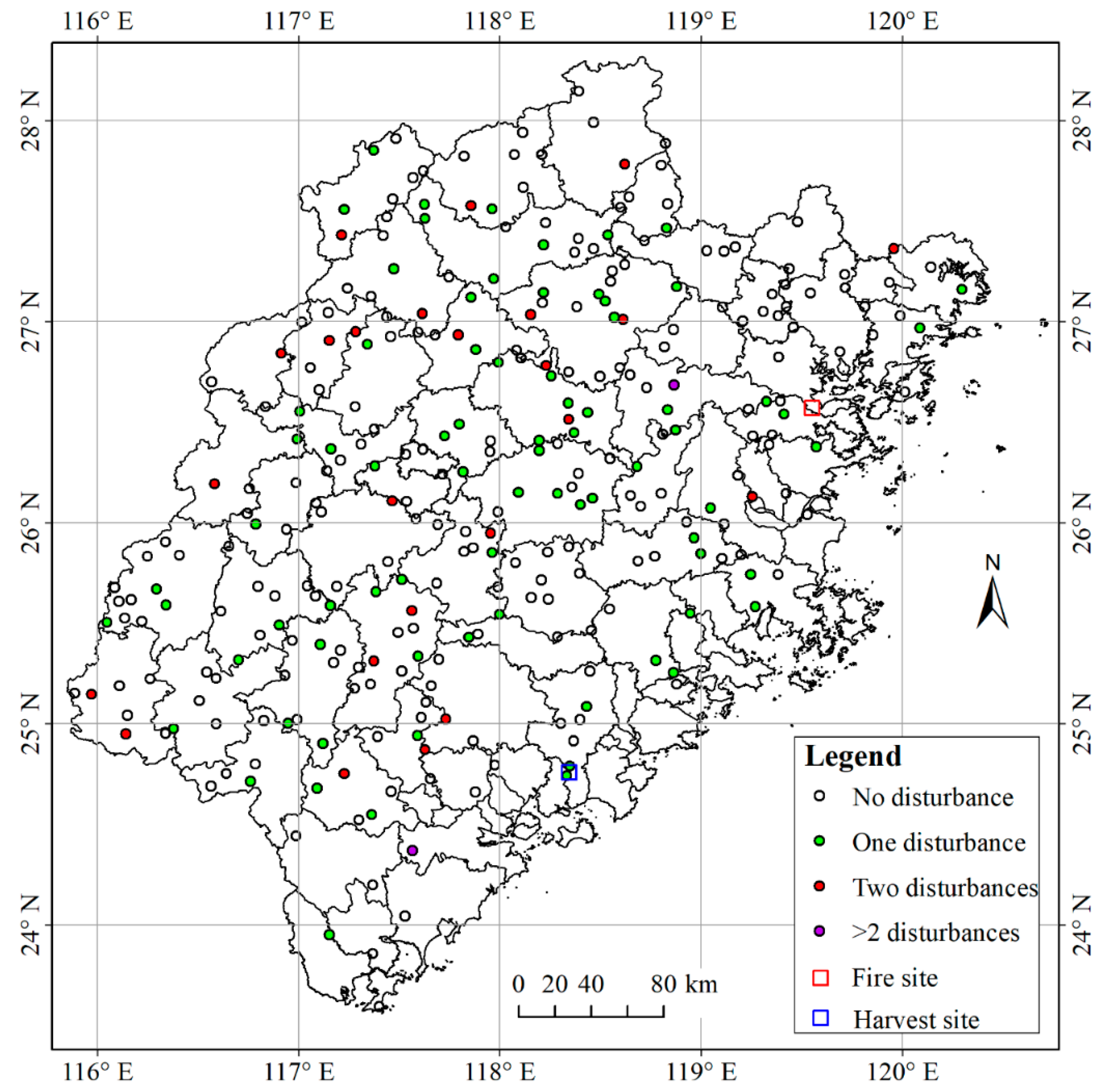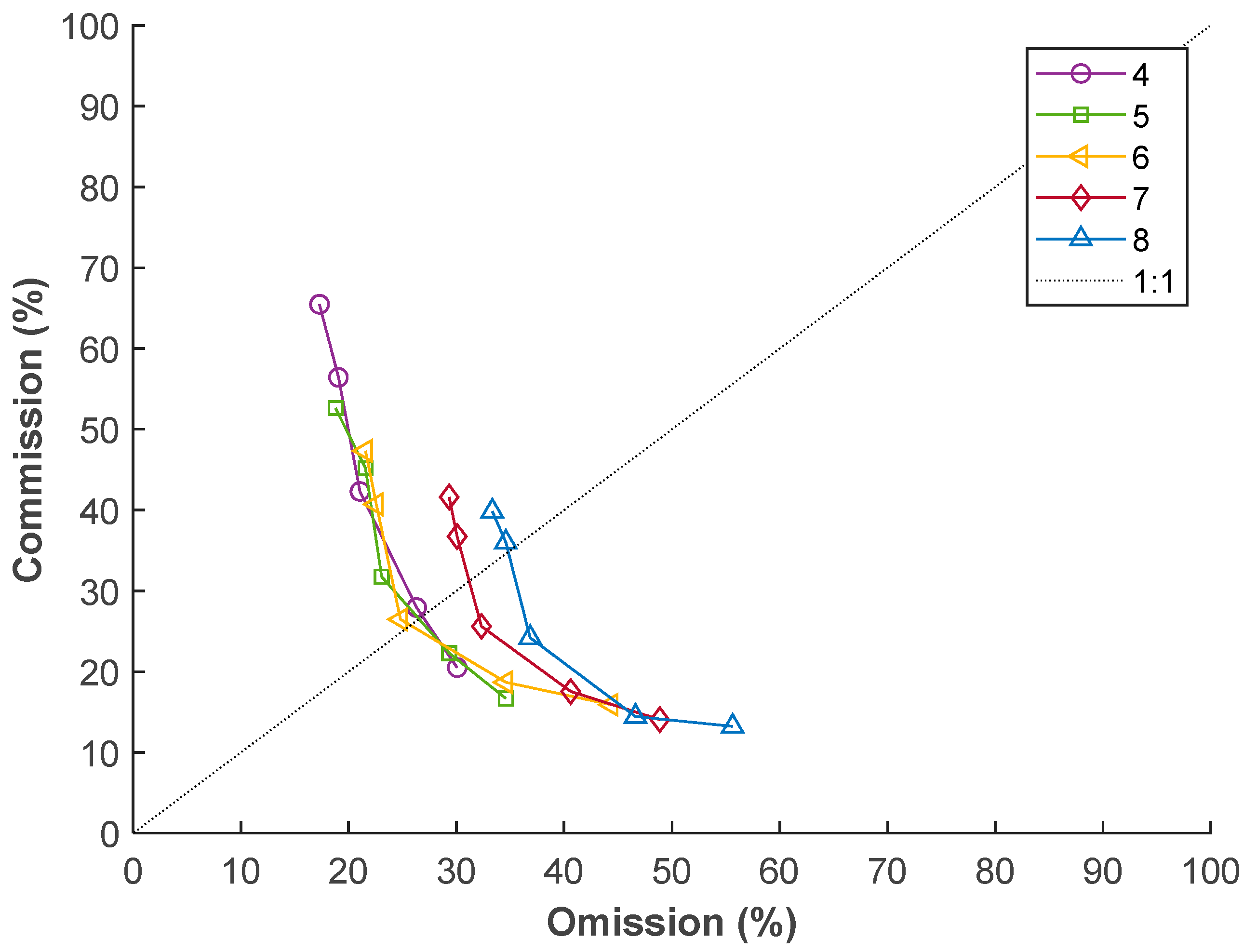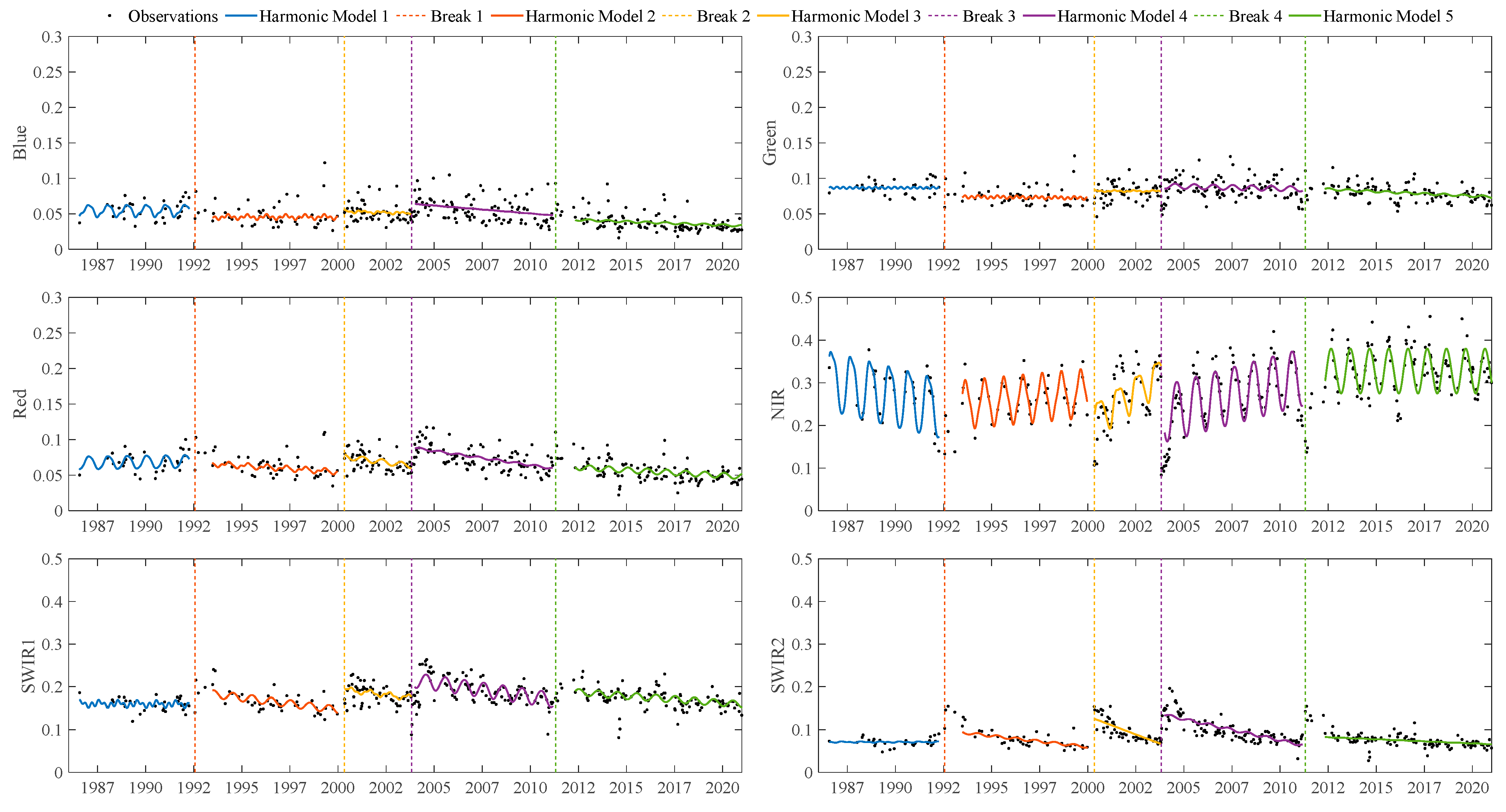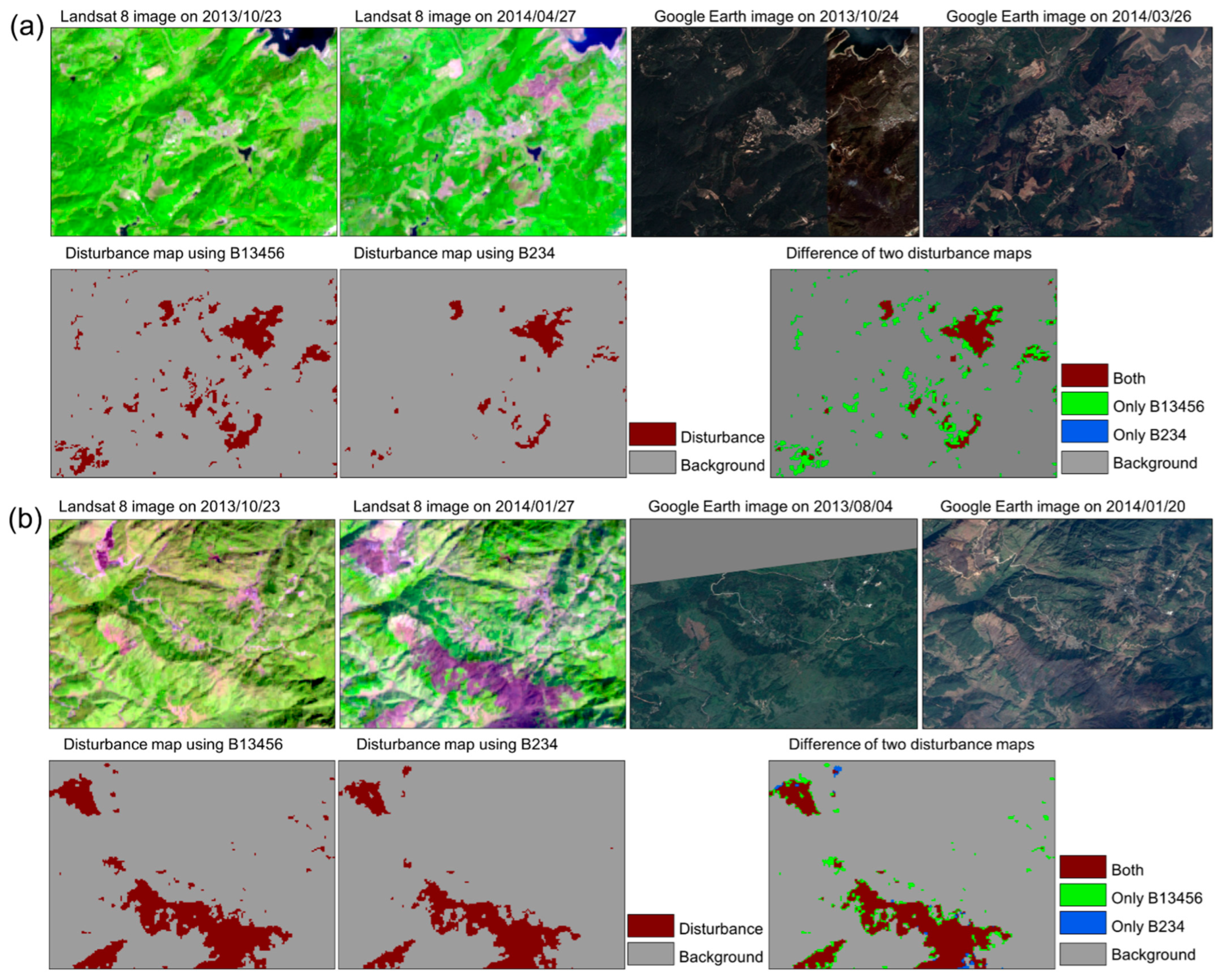The Importance of Adding Short-Wave Infrared Bands for Forest Disturbance Monitoring in the Subtropical Region
Abstract
:1. Introduction
2. Materials and Methods
2.1. Study Area and Data
2.2. Method
3. Results
3.1. Accuracy Assessment with Different Band Combinations
3.2. Forest Harvest and Fire Monitoring Using the Optimal Band Combinations with and without the SWIR Bands
4. Discussion and Conclusions
Author Contributions
Funding
Institutional Review Board Statement
Informed Consent Statement
Acknowledgments
Conflicts of Interest
References
- Pellegrini, A.F.A.; Ahlström, A.; Hobbie, S.E.; Reich, P.B.; Nieradzik, L.P.; Staver, A.C.; Scharenbroch, B.C.; Jumpponen, A.; Anderegg, W.R.L.; Randerson, J.T.; et al. Fire Frequency Drives Decadal Changes in Soil Carbon and Nitrogen and Ecosystem Productivity. Nature 2018, 553, 194–198. [Google Scholar] [CrossRef] [PubMed]
- Walker, X.J.; Baltzer, J.L.; Cumming, S.G.; Day, N.J.; Ebert, C.; Goetz, S.; Johnstone, J.F.; Potter, S.; Rogers, B.M.; Schuur, E.A.G.; et al. Increasing Wildfires Threaten Historic Carbon Sink of Boreal Forest Soils. Nature 2019, 572, 520–523. [Google Scholar] [CrossRef] [PubMed]
- Qin, Y.; Xiao, X.; Wigneron, J.P.; Ciais, P.; Brandt, M.; Fan, L.; Li, X.; Crowell, S.; Wu, X.; Doughty, R.; et al. Carbon Loss from Forest Degradation Exceeds That from Deforestation in the Brazilian Amazon. Nat. Clim. Chang. 2021, 11, 442–448. [Google Scholar] [CrossRef]
- Yu, Z.; Zhou, G.; Liu, S.; Sun, P.; Agathokleous, E. Impacts of Forest Management Intensity on Carbon Accumulation of China’s Forest Plantations. For. Ecol. Manage. 2020, 472, 118252. [Google Scholar] [CrossRef]
- Bowd, E.J.; Banks, S.C.; Strong, C.L.; Lindenmayer, D.B. Long-Term Impacts of Wildfire and Logging on Forest Soils. Nat. Geosci. 2019, 12, 113–118. [Google Scholar] [CrossRef]
- Cohen, W.B.; Healey, S.P.; Yang, Z.; Zhu, Z.; Gorelick, N. Diversity of Algorithm and Spectral Band Inputs Improves Landsat Monitoring of Forest Disturbance. Remote Sens. 2020, 12, 1673. [Google Scholar] [CrossRef]
- Tang, X.; Bullock, E.L.; Olofsson, P.; Woodcock, C.E. Can VIIRS Continue the Legacy of MODIS for near Real-Time Monitoring of Tropical Forest Disturbance? Remote Sens. Environ. 2020, 249, 112024. [Google Scholar] [CrossRef]
- Hansen, M.C.; Loveland, T.R. A Review of Large Area Monitoring of Land Cover Change Using Landsat Data. Remote Sens. Environ. 2012, 122, 66–74. [Google Scholar] [CrossRef]
- Senf, C.; Seidl, R.; Hostert, P. Remote Sensing of Forest Insect Disturbances: Current State and Future Directions. Int. J. Appl. Earth Obs. Geoinf. 2017, 60, 49–60. [Google Scholar] [CrossRef]
- Pessôa, A.C.M.; Anderson, L.O.; Carvalho, N.S.; Campanharo, W.A.; Silva Junior, C.H.L.; Rosan, T.M.; Reis, J.B.C.; Pereira, F.R.S.; Assis, M.; Jacon, A.D.; et al. Intercomparison of Burned Area Products and Its Implication for Carbon Emission Estimations in the Amazon. Remote Sens. 2020, 12, 3864. [Google Scholar] [CrossRef]
- Zhu, Z.; Zhang, J.; Yang, Z.; Aljaddani, A.H.; Cohen, W.B.; Qiu, S.; Zhou, C. Continuous Monitoring of Land Disturbance Based on Landsat Time Series. Remote Sens. Environ. 2020, 238, 111116. [Google Scholar] [CrossRef]
- Boschetti, M.; Stroppiana, D.; Brivio, P.A. Mapping Burned Areas in a Mediterranean Environment Using Soft Integration of Spectral Indices from High-Resolution Satellite Images. Earth Interact. 2010, 14, 1–20. [Google Scholar] [CrossRef]
- Zhao, K.; Wulder, M.A.; Hu, T.; Bright, R.; Wu, Q.; Qin, H.; Li, Y.; Toman, E.; Mallick, B.; Zhang, X.; et al. Detecting Change-Point, Trend, and Seasonality in Satellite Time Series Data to Track Abrupt Changes and Nonlinear Dynamics: A Bayesian Ensemble Algorithm. Remote Sens. Environ. 2019, 232, 111181. [Google Scholar] [CrossRef]
- Ochtyra, A.; Marcinkowska-Ochtyra, A.; Raczko, E. Threshold- and Trend-Based Vegetation Change Monitoring Algorithm Based on the Inter-Annual Multi-Temporal Normalized Difference Moisture Index Series: A Case Study of the Tatra Mountains. Remote Sens. Environ. 2020, 249, 112026. [Google Scholar] [CrossRef]
- Rasheed, F.; Delagrange, S.; Lorenzetti, F. Detection of Plant Water Stress Using Leaf Spectral Responses in Three Poplar Hybrids Prior to the Onset of Physiological Effects. Int. J. Remote Sens. 2020, 41, 5127–5146. [Google Scholar] [CrossRef]
- Huang, C.; Goward, S.N.; Masek, J.G.; Thomas, N.; Zhu, Z.; Vogelmann, J.E. An Automated Approach for Reconstructing Recent Forest Disturbance History Using Dense Landsat Time Series Stacks. Remote Sens. Environ. 2010, 114, 183–198. [Google Scholar] [CrossRef]
- Kennedy, R.E.; Yang, Z.; Cohen, W.B. Detecting Trends in Forest Disturbance and Recovery Using Yearly Landsat Time Series: 1. LandTrendr—Temporal Segmentation Algorithms. Remote Sens. Environ. 2010, 114, 2897–2910. [Google Scholar] [CrossRef]
- Griffiths, P.; Kuemmerle, T.; Baumann, M.; Radeloff, V.C.; Abrudan, I.V.; Lieskovsky, J.; Munteanu, C.; Ostapowicz, K.; Hostert, P. Forest Disturbances, Forest Recovery, and Changes in Forest Types across the Carpathian Ecoregion from 1985 to 2010 Based on Landsat Image Composites. Remote Sens. Environ. 2014, 151, 72–88. [Google Scholar] [CrossRef]
- DeVries, B.; Decuyper, M.; Verbesselt, J.; Zeileis, A.; Herold, M.; Joseph, S. Tracking Disturbance-Regrowth Dynamics in Tropical Forests Using Structural Change Detection and Landsat Time Series. Remote Sens. Environ. 2015, 169, 320–334. [Google Scholar] [CrossRef]
- Drusch, M.; Del Bello, U.; Carlier, S.; Colin, O.; Fernandez, V.; Gascon, F.; Hoersch, B.; Isola, C.; Laberinti, P.; Martimort, P.; et al. Sentinel-2: ESA’s Optical High-Resolution Mission for GMES Operational Services. Remote Sens. Environ. 2012, 120, 25–36. [Google Scholar] [CrossRef]
- Francini, S.; McRoberts, R.E.; Giannetti, F.; Mencucci, M.; Marchetti, M.; Scarascia Mugnozza, G.; Chirici, G. Near-Real Time Forest Change Detection Using PlanetScope Imagery. Eur. J. Remote Sens. 2020, 53, 233–244. [Google Scholar] [CrossRef]
- Zhu, Z.; Woodcock, C.E. Automated Cloud, Cloud Shadow, and Snow Detection in Multitemporal Landsat Data: An Algorithm Designed Specifically for Monitoring Land Cover Change. Remote Sens. Environ. 2014, 152, 217–234. [Google Scholar] [CrossRef]
- Ye, S.; Rogan, J.; Zhu, Z.; Eastman, J.R. A Near-Real-Time Approach for Monitoring Forest Disturbance Using Landsat Time Series: Stochastic Continuous Change Detection. Remote Sens. Environ. 2021, 252, 112167. [Google Scholar] [CrossRef]
- Shang, R.; Zhu, Z.; Zhang, J.; Qiu, S.; Yang, Z.; Li, T.; Yang, X. Near-Real-Time Monitoring of Land Disturbance with Harmonized Landsats 7–8 and Sentinel-2 Data. Remote Sens. Environ. 2022, 278, 113073. [Google Scholar] [CrossRef]
- Chen, S.; Woodcock, C.E.; Bullock, E.L.; Arévalo, P.; Torchinava, P.; Peng, S.; Olofsson, P. Monitoring Temperate Forest Degradation on Google Earth Engine Using Landsat Time Series Analysis. Remote Sens. Environ. 2021, 265, 112648. [Google Scholar] [CrossRef]




| Bands | All Forest Disturbance | Harvest | Fire | ||||||
|---|---|---|---|---|---|---|---|---|---|
| t | c | F1 Score | t | c | F1 Score | t | c | F1 Score | |
| B123456 | 0.99 | 6 | 73.2% | 0.99 | 5 | 72.8% | 0.9999 | 4 | 79.6% |
| B12456 | 0.99 | 6 | 73.0% | 0.99 | 6 | 73.2% | 0.9999 | 4 | 83.0% |
| B13456 | 0.99 | 6 | 74.4% | 0.99 | 6 | 76.3% | 0.9999 | 4 | 86.6% |
| B23456 | 0.99 | 6 | 73.7% | 0.99 | 6 | 75.7% | 0.9999 | 4 | 86.3% |
| B12356 | 0.99 | 6 | 71.0% | 0.90 | 7 | 71.7% | 0.999 | 5 | 75.0% |
| B12346 | 0.99 | 5 | 70.9% | 0.95 | 5 | 70.3% | 0.9999 | 4 | 83.1% |
| B12345 | 0.95 | 6 | 66.7% | 0.99 | 5 | 69.3% | 0.999 | 5 | 76.0% |
| B2346 | 0.99 | 5 | 70.6% | 0.95 | 5 | 72.0% | 0.9999 | 4 | 83.2% |
| B2345 | 0.99 | 6 | 64.6% | 0.99 | 5 | 70.2% | 0.999 | 5 | 72.8% |
| B1346 | 0.99 | 5 | 71.1% | 0.9 | 6 | 73.2% | 0.9999 | 4 | 82.7% |
| B1345 | 0.95 | 6 | 66.2% | 0.9 | 6 | 71.1% | 0.95 | 5 | 71.7% |
| B1234 | 0.9 | 5 | 44.3% | 0.9 | 5 | 47.5% | 0.95 | 4 | 64.1% |
| B234 | 0.9 | 5 | 46.7% | 0.9 | 4 | 49.8% | 0.9 | 4 | 67.6% |
| B124 | 0.9 | 4 | 37.0% | 0.9 | 4 | 36.8% | 0.95 | 4 | 62.2% |
| B134 | 0.9 | 5 | 44.5% | 0.95 | 4 | 46.9% | 0.95 | 4 | 61.3% |
Publisher’s Note: MDPI stays neutral with regard to jurisdictional claims in published maps and institutional affiliations. |
© 2022 by the authors. Licensee MDPI, Basel, Switzerland. This article is an open access article distributed under the terms and conditions of the Creative Commons Attribution (CC BY) license (https://creativecommons.org/licenses/by/4.0/).
Share and Cite
Li, X.; Chen, Y.; Jiang, S.; Wang, C.; Weng, S.; Rao, D. The Importance of Adding Short-Wave Infrared Bands for Forest Disturbance Monitoring in the Subtropical Region. Sustainability 2022, 14, 10312. https://doi.org/10.3390/su141610312
Li X, Chen Y, Jiang S, Wang C, Weng S, Rao D. The Importance of Adding Short-Wave Infrared Bands for Forest Disturbance Monitoring in the Subtropical Region. Sustainability. 2022; 14(16):10312. https://doi.org/10.3390/su141610312
Chicago/Turabian StyleLi, Xi, Yao Chen, Shixiong Jiang, Chongqing Wang, Sunxian Weng, and Dengyong Rao. 2022. "The Importance of Adding Short-Wave Infrared Bands for Forest Disturbance Monitoring in the Subtropical Region" Sustainability 14, no. 16: 10312. https://doi.org/10.3390/su141610312
APA StyleLi, X., Chen, Y., Jiang, S., Wang, C., Weng, S., & Rao, D. (2022). The Importance of Adding Short-Wave Infrared Bands for Forest Disturbance Monitoring in the Subtropical Region. Sustainability, 14(16), 10312. https://doi.org/10.3390/su141610312





